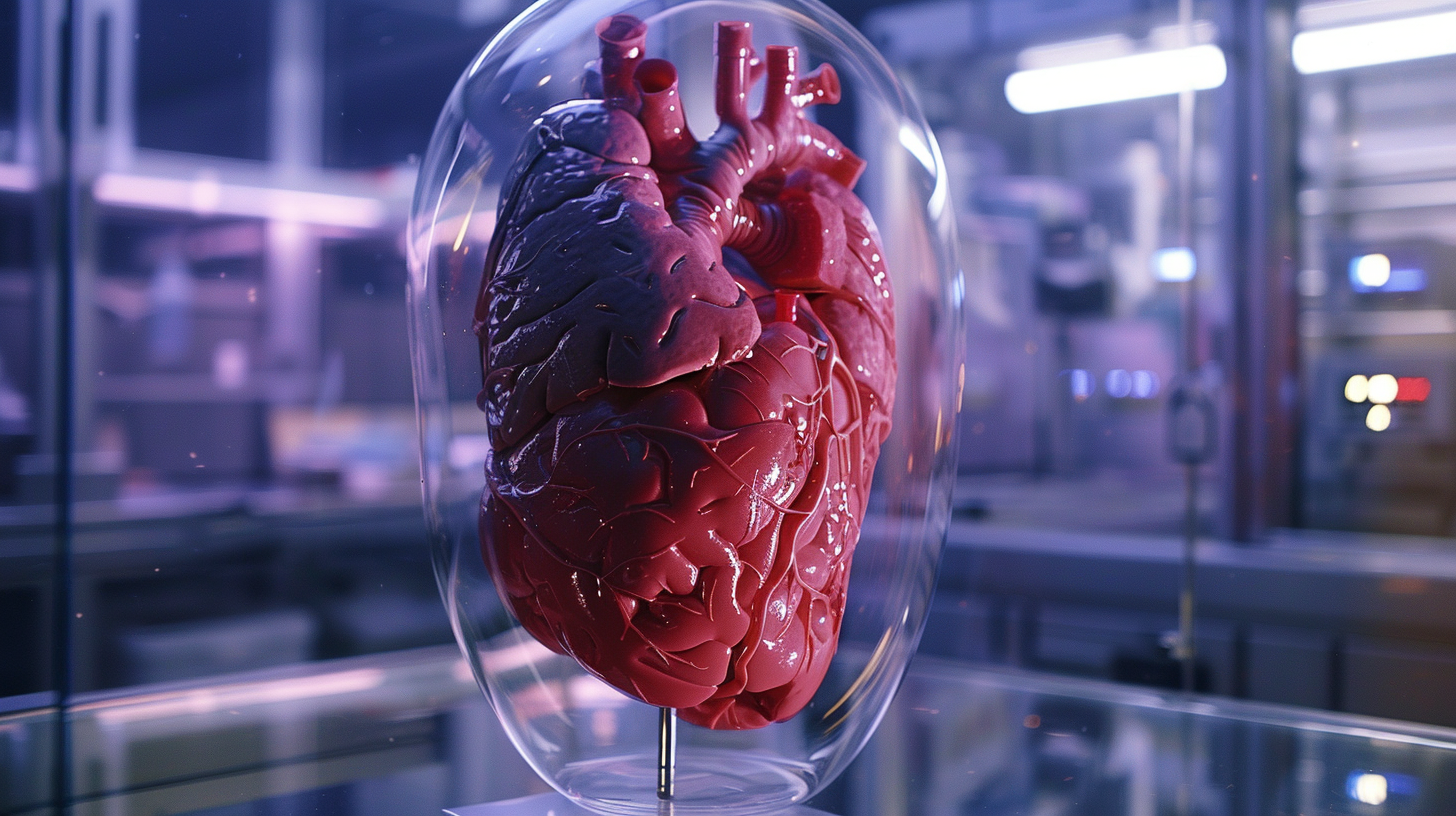Table of Contents Show
At the crossroads of innovation and medicine, we find ourselves pondering the future of life-saving procedures. The advent of 3D bioprinting and lab-grown organs promises to redefine what’s possible in organ transplants, potentially ending the donor shortage crisis. We’re facing a new era where personalized medicine and technological advancements converge to offer tailored solutions. However, the journey ahead is fraught with ethical considerations and technical challenges that need to be navigated carefully. Let’s explore what this means for patients awaiting transplants and how it could reshape healthcare as our understanding evolves, leaving us to question, ‘What comes next?’
Key Takeaways
- 3D bioprinting and lab-grown organs offer solutions to organ shortage and rejection issues.
- Personalized organ creation from stem cells minimizes rejection risks, enhancing transplant success.
- Technological advancements facilitate the development of organs with reduced ethical and regulatory hurdles.
- The future of transplants leans towards minimally invasive surgeries and custom-made organs for better recovery and quality of life.
The Dawn of 3D Bioprinting
Harnessing the power of 3D bioprinting, we’re stepping into a new era of organ transplantation. This innovative technology promises to revolutionize how we approach medical treatments, offering unprecedented freedom to those in need. Up until now, patients requiring organ transplants faced challenging waitlists, fraught with uncertainty and the inherent risk of organ rejection. But we’re on the brink of changing that narrative.
We’re leveraging the precision of 3D bioprinting to create organs tailored to the individual’s body, dramatically reducing the risk of rejection. This isn’t just about offering a solution; it’s about providing a new lease on life, free from the shackles of endless waiting and the specter of incompatibility. The implications are profound, not only for the patients but for the healthcare system at large. We’re talking about a future where organ shortages could become a thing of the past, where the freedom to live isn’t hampered by biological limitations.
But it’s not just about the end product. The journey there is equally transformative. We’re engaging in a process that respects the complexity of human life, aiming to replicate it in its fullness. It’s a bold step, one that requires us to constantly innovate and refine our approach. We’re committed to this path, driven by the belief that everyone deserves the freedom to live without the burden of disease hanging over them.
In essence, 3D bioprinting isn’t just a technological advancement; it’s a beacon of hope. It represents a future where freedom and health go hand in hand, unencumbered by the limitations of today.
Understanding Lab-Grown Organs
We’re now shifting our focus to the fascinating world of lab-grown organs. We’ll explore the basics of how these organs are created, the ethical concerns they raise, and what technological breakthroughs the future might hold. It’s a critical step towards understanding how these scientific advancements could revolutionize the field of organ transplants.
Lab-Grown Organ Basics
Lab-grown organs represent a groundbreaking advancement in medical science, offering new hope for patients waiting for transplants. We’re opening a future where the waitlists for organ transplants could greatly shorten, and the risk of organ rejection decreases. This innovative approach involves creating organs in a lab setting, using a patient’s own cells. This means we’re not just dreaming about a future with enough organs for everyone in need; we’re actively building it.
Ethical Considerations
As we explore the remarkable potential of lab-grown organs, it’s imperative to contemplate the ethical implications of this technology. We’re stepping into a domain where the boundaries of science and ethics blur, raising questions that demand our attention. Here’s what we need to take into account:
- Consent and Source of Cells: Ensuring the cells used for organ creation are ethically sourced, prioritizing consent from donors.
- Accessibility and Equity: Making sure these life-saving technologies are accessible to all, not just the wealthy or privileged.
- Long-term Effects: Understanding the long-term implications on recipients’ health and ensuring these organs don’t introduce unforeseen ethical dilemmas.
We’re not just talking about a medical revolution; we’re envisioning a future that champions freedom, equality, and respect for individual autonomy.
Future Technological Advancements
Delving into the domain of future technological advancements, it’s important to understand how lab-grown organs could revolutionize organ transplants. This leap forward means we’re on the brink of eliminating the agonizing waits and the often tragic shortages in donor organs. Imagine a world where the freedom to live isn’t hindered by the availability of organ donors. Through the cultivation of organs in labs, we’re not just dreaming of a future; we’re building it. This approach offers a tailored solution, greatly reducing the risk of rejection and complications. It’s a path to proof of human ingenuity for patients and a sign of liberation. We’re not just waiting for change; we’re actively creating a future where health freedom is accessible to all.
Key Technologies Behind the Revolution
As we investigate the future of organ transplants, it’s essential to highlight the key technologies propelling this revolution. 3D bioprinting techniques, stem cell innovations, and scaffold design advances stand at the forefront of these transformative approaches. Each plays a pivotal role in crafting the organs that could save countless lives in the near future.
3D Bioprinting Techniques
We’re now exploring bioprinting techniques, the key technologies revolutionizing organ transplants. This groundbreaking approach is not just about creating organs; it’s about giving individuals the freedom to live their lives without the constraints of long waiting lists and the uncertainty of finding a compatible donor. Here’s how we’re doing it:
- Layer-by-Layer Precision: We build organs layer by layer, ensuring each is anatomically correct and functional.
- Bioinks Development: We’re creating bioinks that support cell growth and organ functionality, mimicking the natural environment of human tissues.
- Real-Time Monitoring: We use advanced imaging techniques to monitor organ development, ensuring each bioprinted organ is viable for transplantation.
These techniques promise a future where freedom from disease isn’t just a hope—it’s a reality.
Stem Cell Innovations
Stem cell advancements are unlocking unparalleled possibilities in the organ transplant revolution, providing new hope for patients worldwide. We’re now able to harness the power of these cells to recreate organ tissues in the lab, moving us closer to a future where the wait for a donor organ isn’t a death sentence. This isn’t just about saving lives; it’s about giving people the freedom to live on their terms, without the chains of chronic illness or the uncertainty of organ failure. We’re pushing the boundaries of what’s medically possible, transforming stem cells into a variety of organ cells. This leap forward means we’re not just dreaming about a world where organ shortages are history—we’re actively building it, cell by cell.
Scaffold Design Advances
Behind the scenes of organ transplant innovations, scaffold design advances are playing a pivotal role in shaping the future of regenerative medicine. We’re witnessing a revolution that’s not just promising but delivering the freedom to live fuller lives. Here’s how:
- Customization Through 3D Printing: We’re now able to design scaffolds that precisely match the patient’s anatomy, ensuring a perfect fit and better integration.
- Biodegradable Materials: These materials dissolve after serving their purpose, leaving no foreign objects in the body and reducing long-term complications.
- Incorporation of Growth Factors: By embedding growth factors directly into the scaffold, we’re accelerating tissue regeneration and healing, making organ recovery faster and more efficient.
These advancements are not merely technical milestones; they’re our tickets to liberation from the constraints of organ failure and long waiting lists.
The Process of Creating Organs
To understand how we’re revolutionizing organ transplants, it is important to explore the process of creating organs. We’re breaking free from traditional constraints and venturing into a future where the scarcity of organ donors is no longer a barrier. Our journey begins with the innovative use of 3D printing and lab-grown techniques that promise a new era of medical freedom.
Our method involves several key steps, from initial cell sourcing to the final organ maturation. Let’s delve into the core of this exciting process:
| Step | Description |
|---|---|
| Cell Sourcing | We start by obtaining cells, either from the patient’s own body or from a cell bank, ensuring a match and reducing rejection risks. |
| Scaffolding Creation | Utilizing advances in scaffold design, we create a 3D structure that mimics the organ’s shape. This scaffold provides a framework for cells to grow. |
| Cell Culturing & Seeding | The sourced cells are then expanded and seeded onto the scaffold, where they begin to adhere and multiply, taking on the shape of the organ. |
| Maturation | In a bioreactor, the scaffold with cells undergoes a maturation process, developing into a functional organ. This environment mimics the body’s conditions, promoting growth. |
| Transplant Preparation | Finally, the organ is prepared for transplantation, ensuring it’s compatible and ready to function in the patient’s body. |
We’re not just creating organs; we’re crafting a future where freedom from disease and dependency on organ donors becomes a reality. Through this process, we’re paving the way for a world where anyone in need has access to life-saving organ transplants.
Ethical Considerations
As we explore the future of organ transplants, we must also consider the ethical implications that come with it. Consent and privacy issues, along with equity in organ allocation, present significant challenges we need to address. It’s vital we find balanced solutions that respect individual rights and guarantee fair access for all patients.
Consent and Privacy Issues
We must address the complex ethical issues surrounding consent and privacy in organ transplants. As we venture into the uncharted territories of 3D printing and lab-grown organs, we’re stepping into uncharted territories where the rules of consent and privacy need a fresh look. Here’s what’s at stake:
- Ownership and Consent: Who owns a lab-grown organ? And how do we make sure donors or cells providers have given informed consent?
- Data Privacy: Protecting the genetic information of donors is paramount. How do we safeguard this sensitive info?
- Consent Revocation: Can a donor withdraw consent if their biological material is already in use?
We’re committed to exploring these waters carefully, making sure that everyone’s freedom and privacy are respected every step of the way.
Equity in Organ Allocation
Exploring the ethical landscape of organ allocation, we confront the critical issue of guaranteeing equity for all patients in need. It’s paramount that everyone, regardless of socioeconomic status, race, or location, has equal access to life-saving transplants. The advent of 3D printing and lab-grown organs holds promise for expanding the organ pool, potentially democratizing access. However, we must vigilantly guarantee these technologies don’t inadvertently widen existing disparities. We’re advocating for transparent, fair allocation systems that prioritize patient needs above all else. Let’s champion policies that guarantee these innovations benefit everyone equally, embodying our collective commitment to freedom and equity in healthcare. Together, we can forge a future where life-saving transplants are accessible to all, marking a new era of fairness in organ allocation.
Overcoming Organ Rejection
Overcoming organ rejection remains a critical challenge in transplant medicine, demanding innovative solutions and persistent research efforts. As we delve into the future of organ transplants, we’re committed to breaking down barriers and unraveling new paths to freedom for patients worldwide. We’re exploring groundbreaking approaches to guarantee that once a patient receives a new organ, their body welcomes it with open arms. Here’s how we’re tackling this:
-
Tailored Immunosuppressive Therapy: We’re moving beyond one-size-fits-all solutions, developing personalized medication regimens that adjust to each patient’s unique immune response. This targeted approach minimizes side effects and maximizes acceptance, offering a smoother post-transplant journey.
-
Bioengineering Organs: By bioengineering organs to closely match the recipient’s tissue, we’re reducing the risk of rejection. This technique ensures that the transplanted organ isn’t seen as an intruder by the patient’s body, paving the way for a successful integration.
-
Advanced Monitoring Techniques: We’ve adopted cutting-edge technologies to monitor for signs of rejection earlier than ever before. Early detection means prompt intervention, noticeably improving the odds of organ acceptance and long-term functionality.
We’re on a mission to grant everyone the freedom to live without the shadow of organ rejection looming over them. By pushing the boundaries of what’s possible in transplant medicine, we’re not just saving lives; we’re revolutionizing the way we think about organ compatibility and patient care. Together, we’re charting a course towards a future where organ rejection is a concern of the past.
The Role of Stem Cells
Harnessing the power of stem cells opens up unparalleled opportunities in the domain of organ transplants, presenting promising strategies to combat organ rejection effectively. We’re tapping into a world where the very building blocks of life can be guided to form organs that our bodies won’t see as foreign, giving us the keys to access a future with fewer limitations.
At the heart of this revolution is the ability to use a patient’s own stem cells to grow organs in a lab. This isn’t just science fiction; it’s the doorway to reducing the need for lifelong immunosuppressants and the associated side effects, granting patients a shot at a life unchained from constant medical oversight.
To break it down, here’s a simple table illustrating the pivotal role stem cells play in the future of organ transplants:
| Aspect | Benefit | Impact on Freedom |
|---|---|---|
| Personalization | Reduces organ rejection | More successful transplants |
| Availability | Increases organ supply | Less waiting time |
| Long-term Health | Decreases reliance on drugs | Improved quality of life |
We’re on the cusp of a medical revolution where the freedom to live a life without the shadow of organ failure or rejection looms large. Stem cells offer us a beacon of hope, a promise of a future where our bodies and the technology that supports them can integrate seamlessly. It’s a thrilling time to look forward to, as we continue to push the boundaries of what’s possible in organ transplants, ensuring that freedom and health go hand in hand.
Current Success Stories
Several breakthroughs in the field of organ transplants have turned once-dreamed scenarios into tangible success stories. As we dive deeper into this exciting frontier, we’ve seen firsthand how innovation is not just reshaping lives but also offering a new domain of freedom to those who once faced bleak prospects. Here’s a closer look at some of the thrilling advancements:
-
Lab-Grown Bladders: The first successful transplant of a lab-grown bladder into a human patient marked a monumental step forward. This technique involves using the patient’s own cells, greatly reducing the risk of rejection and opening doors to more personalized organ transplants.
-
3D Printed Heart Tissues: Scientists have successfully printed living heart tissues that beat just like a real heart. This achievement is not just a leap towards full organ printing but also offers a path to test drugs in a more heart-like environment, potentially saving lives before transplants are even needed.
-
Kidney Replicas for Transplant Practice: Surgeons are now using 3D printed replicas of patients’ kidneys to practice complicated transplants beforehand. This preparation has led to shorter surgery times and improved outcomes, proving that the freedom to innovate can directly translate into freedom from disease for many.
These stories aren’t just steps toward the future; they’re leaps towards a world where the freedom to live isn’t limited by the availability of organs. As we continue to push boundaries, we’re not just witnessing the future of medicine; we’re actively participating in its creation.
Regulatory Hurdles
Exploring the intricate landscape of regulations presents a significant challenge in the progression of organ transplant technologies. We’re stepping into a future where the potential to save lives with 3D printed and lab-grown organs is immense. Yet, we find ourselves entangled in a web of regulatory frameworks that, while designed to guarantee safety and efficacy, can also stifle innovation and delay the freedom to save lives.
We’re advocating for a balance—a way to navigate the regulatory maze without compromising on safety or the spirit of innovation. The current regulations, often outdated, don’t fully encompass the novelty and potential of these emerging technologies. We’re pushing for regulatory bodies to adapt and evolve, to understand the urgency of our mission. The development of a streamlined, transparent, and efficient regulatory process is pivotal. It’s about ensuring that these groundbreaking technologies don’t just remain a possibility but become a reality, offering hope to those in dire need of organ transplants.
Furthermore, we’re urging for the involvement of all stakeholders—scientists, patients, ethicists, and policymakers—in shaping a regulatory environment that fosters growth and freedom. By working together, we can dismantle the barriers that stand in the way of progress. We believe in a future where regulatory hurdles don’t hamper the advancement of organ transplant technologies but rather guarantee they’re safely integrated into healthcare systems. It’s a future we’re determined to realize, for the sake of those waiting for a second chance at life.
Future of Transplant Surgery
The future of transplant surgery promises remarkable advancements, with innovations like 3D-printed organs poised to revolutionize the field. We’re on the brink of a transformation that’ll liberate patients worldwide from the shackles of lengthy waitlists and the constraints of compatibility issues. This leap forward isn’t just a dream; it’s becoming our reality, offering newfound hope and freedom to those in need.
Here’s what we’re looking forward to:
-
Tailor-Made Organs: Imagine receiving an organ that’s custom-made for your body. No more rejection fears or endless medications. With 3D printing and lab-grown technologies, we’re stepping into an era where organs can be created to match the patient’s specific biological requirements. This means surgeries will be more successful, recovery times shorter, and the quality of life notably improved.
-
Minimally Invasive Procedures: The precision of these future technologies will allow for surgeries that are less invasive, reducing risks and speeding up recovery. We’ll see a shift from traditional open surgeries to procedures that barely leave a mark, offering patients the freedom to return to their lives much faster.
-
Rapid Advancements in Surgical Robots: The integration of AI and robotics in transplant surgeries will enhance precision and efficiency, allowing surgeons to perform complex procedures with unmatched accuracy. This isn’t just about improving outcomes; it’s about redefining the possibilities of what can be achieved in operating rooms.
We’re not just waiting for the future; we’re actively building it. With these advancements, we’re opening doors to a world where freedom from illness isn’t just a possibility—it’s a promise.
Reducing the Donor Gap
While we’re making strides in technology and surgery techniques, it’s equally important to address the donor gap that many patients face. This disparity between the number of available organs and those in need stifles our quest for medical freedom, leaving countless individuals tethered to waiting lists, their hopes dimming with each passing day. We’re committed to demolishing this barrier, making sure that everyone has the chance to live life to its fullest, unencumbered by disease or the ticking clock of organ failure.
We’re embracing innovative solutions like 3D-printed organs and lab-grown tissues, which promise to reduce, if not completely eliminate, our reliance on donor organs. By harnessing the power of these technologies, we can produce organs on demand, tailored to the patient’s needs without the lengthy wait or the risk of rejection. This autonomy in healthcare is not just a leap forward; it’s a revolution, offering a beacon of hope to those who’ve been waiting in the shadows.
Furthermore, we’re advocating for policy changes and increased public awareness to encourage organ donation. It’s clear that while we work towards a future of readily available lab-grown organs, we must not neglect the power of human compassion and altruism. By creating a culture that values organ donation, we can bridge the gap until technological advancements are fully realized.
Personalized Medicine Advancements
Advancements in personalized medicine are revolutionizing the way we approach healthcare, tailoring treatments to the individual’s genetic makeup for unprecedented outcomes. With the power of cutting-edge technology, we’re stepping into a future where medical care is not just about treating symptoms but preventing diseases before they manifest, ensuring each one of us gets the freedom to enjoy a healthier life.
Here are three ways personalized medicine is changing the game:
-
Precision Diagnostics: We’re now able to analyze a person’s genetic information to predict and diagnose diseases with astounding accuracy. This means we can catch health issues early on, sometimes even before symptoms appear, giving us the upper hand in treatment.
-
Customized Treatment Plans: Gone are the days of one-size-fits-all medicine. We’re moving towards treatments designed specifically for an individual’s genetic profile. This not only boosts the effectiveness of the treatment but also minimizes side effects, making the healing process smoother and faster.
-
Advanced Drug Development: By understanding a patient’s genetic makeup, pharmaceutical companies can develop drugs tailored to work more effectively with fewer risks. This leads to safer, more efficient medications that align with the patient’s unique biological characteristics.
Personalized medicine is not just a fleeting trend; it’s the future of healthcare. It offers us the freedom to receive care that’s as unique as our DNA, paving the way for a healthier society. As we continue to unleash the potential of this innovative approach, the possibilities for what we can achieve are limitless.
Challenges and Limitations
Despite the significant strides made in personalized medicine, we’re facing obstacles that challenge its widespread implementation and effectiveness. The promise of a future where organ shortages are a thing of the past is within our grasp, but it’s not without its impediments. We’re maneuvering through a complex landscape, where technological innovation meets ethical quandaries, and where our thirst for freedom and health confronts reality’s constraints.
| Challenge | Emotional Impact |
|---|---|
| Technological Limits | Frustration at the pace of progress |
| Ethical Concerns | Moral distress over the source and use of lab organs |
| Regulatory Hurdles | Impatience with slow-moving approval processes |
| Cost Accessibility | Anger and despair over life-saving tech being out of reach |
| Organ Compatibility | Heartache for those waiting on a perfect match |
These challenges encapsulate not just the technical difficulties we’re encountering but also the emotional rollercoaster those in need of organ transplants and their families endure. The roadblocks in technology and ethics highlight a clash between our desire for innovation and our commitment to moral principles. Meanwhile, regulatory and cost barriers remind us that freedom isn’t just about having options—it’s about having accessible options.
As we push forward, it’s clear that achieving our dream of universally accessible organ transplants will require not just scientific breakthroughs but a societal shift. We’re struggling for a future where freedom from illness isn’t just a possibility but a reality for everyone. The journey ahead is fraught with challenges, but it’s one we’re committed to overcoming together.
Collaborative Efforts in Research
As we explore the future of organ transplants, it’s clear that collaboration plays a pivotal role. Global research partnerships, interdisciplinary team dynamics, and robust funding and support mechanisms are essential ingredients for breakthroughs. Together, we’re forging paths toward innovative solutions that promise to overcome current challenges in the field.
Global Research Partnerships
We’re witnessing a transformative era where global research partnerships are greatly accelerating progress in organ transplant technologies. These collaborations are not just enhancing the pace but are expanding the horizons of what’s possible, offering new freedoms in medical science and patient care. Here’s why they’re so essential:
- Sharing of Knowledge and Resources: By pooling our talents and tools, we’re breaking down barriers faster than ever.
- Diversification of Perspectives: Different cultural and scientific backgrounds lead to innovative solutions, pushing the boundaries of traditional approaches.
- Speeding Up Clinical Trials: International partnerships mean we can conduct simultaneous trials in multiple locations, getting life-saving technologies to those in need much quicker.
Together, we’re not just dreaming of a future with more accessible organ transplants; we’re actively building it.
Interdisciplinary Team Dynamics
Harnessing the power of interdisciplinary teams, we’re revolutionizing organ transplant research through collaborative efforts. By combining the expertise of biologists, engineers, and computer scientists, we’re breaking down traditional silos to foster innovation. This synergy isn’t just about pooling skills; it’s about creating a space where freedom of thought and action propels us forward. We’re not confined by the boundaries of our disciplines, allowing us to explore uncharted territories in organ fabrication. Our team dynamics encourage open dialogue, critical thinking, and rapid prototyping, ensuring that creative solutions are not just welcomed but celebrated. As we navigate this complex landscape together, we’re setting the stage for groundbreaking advancements that promise to redefine the future of organ transplants, giving hope to thousands waiting for a second chance at life.
Funding and Support Mechanisms
While our interdisciplinary teams push the boundaries of organ transplant research, securing adequate funding and support becomes a key factor in sustaining our innovative efforts. To assure our freedom to explore and innovate, we’ve identified three main avenues for funding:
- Government Grants and Subsidies: These provide us with the essential backing to conduct preliminary studies and prove our concepts.
- Private Sector Partnerships: Collaborating with industry leaders not only brings in financial investment but also invaluable expertise and resources.
- Crowdfunding and Public Support: Engaging the community directly allows us to share our vision and gather support from those who believe in the transformative potential of our work.
Together, these mechanisms enable us to forge ahead, breaking new ground in the quest for life-saving organ transplant solutions.
The Next Decade in Transplantation
How will the next decade transform the landscape of organ transplantation, pushing the boundaries of medical science? We’re standing at the cusp of a revolution that promises not just to innovate but to liberate countless individuals worldwide. With the advent of 3D printing and lab-grown organs, we’re looking at a future where the concept of waiting lists becomes obsolete, where the fear of organ rejection is a thing of the past.
We’re not just dreaming; we’re actively forging a path towards this future. The next ten years will see us perfecting the techniques to grow organs in labs from patients’ own cells. This means organs that are a perfect match, significantly reducing the risk of rejection and the need for lifelong immunosuppressants. Imagine a world where you can receive a new heart, liver, or kidney without the agonizing wait or the dread of compatibility issues.
We’re also pushing the envelope with 3D printing technology, aiming to print not just simple tissues but complex, functional organs. This isn’t science fiction—it’s the future of medicine, and it’s unfolding right before our eyes.
But it’s not just about the technological advances; it’s about what they represent. Freedom from disease, freedom from fear, and freedom to live a life unchained by medical limitations. We’re on the brink of a new era in healthcare, one where the impossible becomes possible, and where freedom is not just a dream but a reality.
Conclusion
To wrap up, we’re standing on the brink of a medical revolution that promises to eclipse the miracles of ancient myths. Through the marvels of 3D bioprinting and lab-grown organs, the future of organ transplants is beaming brighter than ever. Despite the hurdles ahead, our collective efforts in research and technology are paving the way for groundbreaking advancements in personalized medicine. Together, we’re not just rewriting the rules of transplantation; we’re reshaping the very fabric of life itself.








